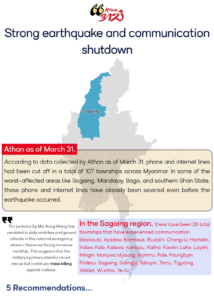Strong earthquake and communication shutdown
On the afternoon of March 28 (12:51 PM Myanmar Standard Time), a powerful earthquake with a magnitude of 7.7 struck approximately 16 kilometers northwest of Sagaing, Myanmar. The severe quake and its aftershocks caused widespread destruction across various regions including Sagaing, Mandalay, Tada-U, Myittha, Bago, Pyawbwe, Naypyitaw, Amarapura, Pyinmana, Taungoo, and southern Shan State. Buildings, historic pagodas, Islamic religious structures, roads, and bridges were damaged or collapsed and the death toll passed 3,300, while tens of thousands were injured. The United States Geological Survey (USGS) has estimated that more than 10,000 people in Myanmar could potentially die due to the earthquake.
Currently, emergency aid is urgently needed in many affected areas for rescue operations, drinking water, ready-to-eat food, medicine, electricity, and hygiene supplies. However, the military has cut off phone and internet access in most of these areas, leading to severely restricted news flow. According to data collected by Athan as of March 31, phone and internet lines had been cut off in a total of 107 townships across Myanmar. In some of the worst-affected areas like Sagaing, Mandalay, Bago, and southern Shan State, these phone and internet lines have already been severed even before the earthquake occurred. After the quake struck, the damage to buildings worsened communication disruptions. However, even before the earthquake, the military had already cut off communication lines and was continuously committing severe human rights violations — including the burning down of entire villages where civilians lived, the arbitrary killing of local residents, and relentless airstrike attacks.

Due to the communication blackout, banking services in those areas had to be suspended, which has caused economic difficulties for local people in the regions. Moreover, this also led local people unable to contact family members living afar and access essential health information. Even hours after the quake, news from the ground was slow to reach media outlets. Rescue and humanitarian aid efforts were delayed and insufficient, which are largely claimed due to the military’s control over communications.
In fact, rescue teams only arrived in Sagaing—where 80% of the city was destroyed—on the evening of March 30. This raises questions about the military’s inefficiency or possible deliberate obstruction. Meanwhile, local defense forces under the National Unity Government (NUG) and other ethnic armed groups have officially declared ceasefires with the military. However, the military continues its offensives in conflict-driven areas amid the international calls urging the junta to halt airstrikes and ground assaults. The junta led by Min Aung Hlaing has persisted in daily airstrikes and ground attacks in this national emergency, where citizens are facing immense hardship. This suggests that the military’s primary intention is not rescue but continued mass killing against civilians.
Recent reports also indicate that in the immediate aftermath of the earthquake, the military launched large-scale ground assaults and airstrikes in several regions. On April 2, the junta announced a temporary 20-day ceasefire from April 2 to 22, claiming it aimed to support rescue and rehabilitation efforts. Despite the ceasefire declaration, reports on April 2 confirmed continued artillery shelling of villages along the Pathein–Monywa road and that civilians were fleeing during the night. As of the morning of April 3, artillery attacks continued in areas around Waimaw, Kachin State.Moreover, in many affected areas, the military has yet to restore phone or internet access. Even in areas that previously had connectivity, people now face electricity outages and communication blackouts. While Elon Musk’s company SpaceX has announced their willingness to offer to support Myanmar with Starlink satellite communication equipment, the relevant approval steps still need to be implemented.
Recommendations
- The junta should immediately restore access to mobile phone and internet networks.
- The military must immediately cease all airstrikes (bombings) and ground assaults.
- Priority should be given to repairing communication infrastructure and electricity supply systems damaged by the earthquake.
- To ensure that international aid and relief supplies are delivered to areas in need on the ground and are utilised effectively and efficiently for maximum impact.
- Telecommunications companies should exert pressure on the military to reinstate communication lines during this natural disaster period, especially where the junta has cut access.
- In areas where mobile towers have been destroyed due to the earthquake, telecom companies should deploy mobile tower trucks to restore connectivity.
- In territories controlled by local defense forces and ethnic resistance organizations, arrangements should be made to enable local communities to use Starlink internet services (as was done previously).
- The international communities should support the organizations from various relevant fields (not the military) that are working hard and trying to enable communication networks and channels in Myanmar.
